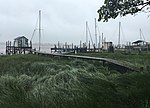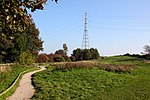Shard Riverside Inn
1766 establishments in EnglandBuildings and structures in the Borough of WyreHambleton, LancashireHotels in LancashireLancashire building and structure stubs ... and 4 more
Pub stubsPubs in LancashireRestaurants in LancashireUse British English from November 2021

Shard Riverside Inn is a public house and boutique hotel in the English village of Hambleton, Lancashire. Dating to 1766, it stands on the northern banks of the River Wyre, about 600 feet (180 m) east of Shard Bridge, for which it is named. The bridge used to be immediately to the west of the building, but a new structure (the third overall) was built in 1993, a few yards downstream, and its predecessor demolished. The building's address, Old Bridge Lane, references this.
Excerpt from the Wikipedia article Shard Riverside Inn (License: CC BY-SA 3.0, Authors, Images).Shard Riverside Inn
Old Bridge Lane, Borough of Wyre Hambleton
Geographical coordinates (GPS) Address Nearby Places Show on map
Geographical coordinates (GPS)
| Latitude | Longitude |
|---|---|
| N 53.8629958 ° | E -2.958874055 ° |
Address
Shard Riverside Inn
Old Bridge Lane
FY6 9BT Borough of Wyre, Hambleton
England, United Kingdom
Open on Google Maps










